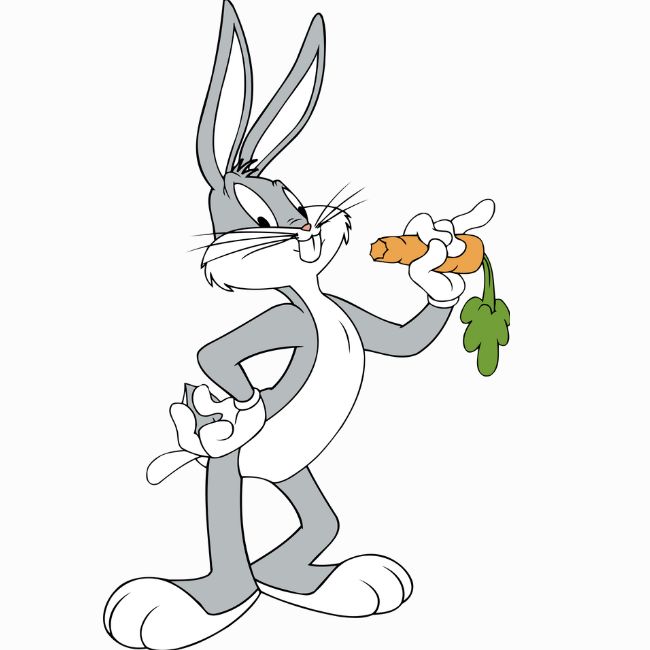
Bugs Bunny and his ever-present carrot!
Recommended for Foundational Grades
The story of Bugs Bunny, an iconic animated cartoon character, is a captivating journey through the history of American animation and culture. Known for his relaxed demeanor and mischievous antics, Bugs Bunny has become more than just a character; he’s an emblem of American wit and humor.
His evolution from a prototype to a beloved cultural icon encapsulates not only advancements in animation but also reflects societal changes and the enduring appeal of a clever trickster.
Listen to the summary
The Origin and Evolution of Bugs Bunny
- From Prototype to Pop Culture Icon: Bugs Bunny’s journey began in the 1940s as a creation for Warner Bros.’ Looney Tunes and Merrie Melodies series. Initially voiced by the legendary Mel Blanc, Bugs quickly became a standout character.
- He symbolized the Golden Age of American Animation, a period marked by significant advancements in the animation industry. His debut in “A Wild Hare” set the stage for his future fame.
- Character Development and Artistic Contributions: Over the years, various animators sculpted Bugs Bunny’s image and personality. Each contributed unique elements, from his iconic Mid-Atlantic accent, a blend of Brooklyn and Bronx, to his relaxed, passive demeanor. This collaboration led to a character who consistently outsmarted his opponents with wit and humor, making him a beloved figure in animation.
- An example of this cleverness is seen in episodes where Bugs Bunny famously outwits Elmer Fudd, leaving audiences both amused and impressed.
- Adaptation Through the Decades: Bugs Bunny has adapted to changing times while maintaining his core characteristics. His ability to remain relevant and engaging, whether through his classic catchphrase “Eh, what’s up, doc?” or his timeless antics, speaks to the character’s flexibility and enduring appeal.
- His adaptability is evident in how he transitioned from classic short films to feature-length movies, television shows, and even video games, captivating new audiences with each generation.
Cultural Impact and Wartime Influence
- Symbolism During World War II: During the 1940s, Bugs Bunny took on a role beyond entertainment; he became a symbol of American spirit and resilience. His cartoons were used in American propaganda efforts during World War II. Bugs even donned a military uniform in “Super-Rabbit,” leading to his honorary title as a Master Sergeant in the U.S. Marine Corps. This involvement illustrated how a cartoon character could inspire and uplift a nation during challenging times.
- Legacy as a Cultural Icon: Beyond his entertainment value, Bugs Bunny became a cultural icon. His influence is evidenced by his star on the Hollywood Walk of Fame and being named the greatest cartoon character of all time by TV Guide in 2002.
- His ability to connect with audiences across various demographics made him more than just a character; he became a part of American cultural heritage.
- Influence on Internet Culture and Memes: Bugs Bunny’s relevance has extended into the digital age, with his images and phrases becoming popular in internet memes.
- This modern adaptation showcases his continuous impact on popular culture, resonating with a digital audience and keeping the character alive in contemporary dialogues.
Expansion into Various Media and Modern Appearances
- Diversification into Multiple Platforms: Bugs Bunny’s appeal led to his expansion into various forms of media. He starred not just in animated shorts but also in feature films, television series, comic books, and video games.
- His role in the 1988 film “Who Framed Roger Rabbit” and the successful “Space Jam” series are prime examples of how Bugs Bunny bridged the gap between animation and live-action, introducing him to a broader audience.
- Modern Television and Film Appearances: In recent years, Bugs Bunny has been reintroduced to new generations through shows like “The Looney Tunes Show” and “New Looney Tunes.”
-
- Continued Legacy and Popularity: Bugs Bunny’s sustained popularity is a testament to his timeless appeal. Whether through nostalgic references in modern media or his presence in internet culture, he continues to be a symbol of humor, cleverness, and cultural significance.
- His ability to evolve while maintaining his core essence ensures that Bugs Bunny remains a beloved character worldwide.
Reflection
Bugs Bunny, a creation of collaborative genius, represents more than just an animated character. He embodies a spirit of cleverness, resilience, and humor that resonates with audiences across different ages and cultures.
His journey from a mere cartoon rabbit to an international symbol of humor and wit illustrates the power of storytelling and character creation in shaping cultural icons.
As we reflect on his history and legacy, Bugs Bunny remains a testament to the enduring appeal of a character who can make us laugh, think, and, most importantly, connect with the joy of our childhoods.
Similar Stories
- Pink Panther and his naughty tricks!
- Daffy Duck – Warner Brothers’ beloved!
- Tweety – Everyone’s favourite innocent yellow bird!
- Marvin the Martian – Meet the visitor from Mars!
- Speedy Gonzales – “The Fastest Mouse in all Mexico”
Watch a video
Bugs Bunny and Coyote Genius are up to some mischief. Check out the following clip shared by WB Kids.
